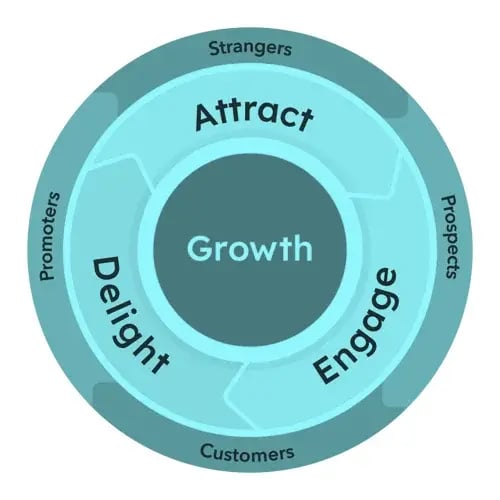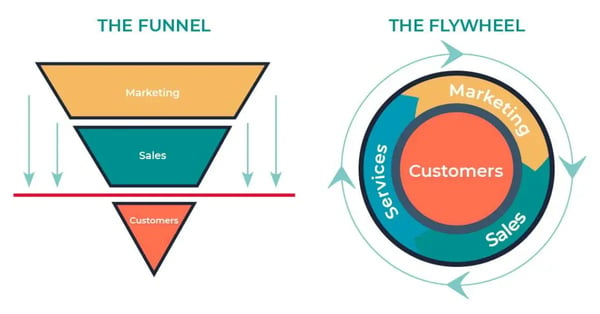For a long time, businesses have used the marketing funnel to show how they attract leads and turn them into customers. This method starts with many leads that get narrowed down as they get closer to making a purchase.
But this way of thinking doesn’t really match up with how people shop today. With the internet, customers have more control over how they buy things. They often research and compare products online, which means they expect more from their experience with businesses.
HubSpot's Sales Flywheel Model understands these changes and offers a fresh approach to growing your business. Instead of just pushing leads through a funnel, it focuses on creating a great experience that keeps customers coming back and telling others about you.
Understanding the Flywheel Model
HubSpot has transformed the sales flywheel into a strategy that puts the customer experience at the heart of everything. This approach not only drives sales but also keeps the business growing as happy customers spread the word about your brand.

By focusing on a sales flywheel, businesses create a great customer experience from the very first interaction, building strong customer loyalty. Instead of constantly chasing new leads, they ensure their existing customers keep coming back and bringing others with them.
The sales flywheel has three main parts. First is the "attract" phase, where you bring in new customers through word-of-mouth and inbound marketing.
Next is the "engage" phase. Here, you provide customers with personalized content that meets their specific needs. Finally, there's the "delight" phase, where you offer an exceptional experience that turns customers into brand advocates. These advocates share their positive experiences, attracting even more customers.
Strategies to Energize the Sales Flywheel with HubSpot
As impressive as this strategy sounds, businesses often wonder how to get the flywheel moving. That first push can feel like the toughest part. However, here are some practical techniques to help you get started.
Leverage your strong customer testimonials
Customer testimonials are a powerful way to get your flywheel moving. They provide word-of-mouth authenticity, showing potential customers what others think of your brand. Display testimonials prominently on your website. If customers post testimonials on their own social media pages, share their content on your profile to amplify their message.
Create social proof through social media
Social media plays a crucial role in today's sales process. It helps you broadcast your brand and connect with both existing and potential customers. Create lively pages that spark conversation by sharing helpful content, asking questions, and responding to comments and messages. Consider hosting contests and encouraging user-generated content to boost engagement.
Identify the areas of force that drive the flywheel
Examine your successful conversions to understand what drives people to buy. Look at the content they interacted with before making a purchase. Talk to these customers to learn why they chose you over others in your industry. As you identify patterns in what motivates people to buy, focus on those areas to keep your flywheel turning.
Find and eliminate sources of friction
Similarly, identify any sources of friction that might prevent people from buying. These could be simple issues, like too many steps in the checkout process or a slow-loading website. Removing these obstacles will help your flywheel spin faster.
Overall, you’ll keep your flywheel moving by deeply understanding your target audience. Know what motivates them and what challenges they face. Find out where they spend time online and what makes your product stand out. Offer expert advice to build your credibility and encourage engagement.
Comparing the Sales Funnel and the Flywheel Model

When you compare the traditional sales funnel to the flywheel model, you'll notice several similarities. Both aim to attract and engage customers to encourage conversions. However, the flywheel model keeps customers at the center, making them a continuous part of your brand, unlike the funnel where customers simply pass through.
This customer-centric approach can boost business efficiency and enhance engagement. Word-of-mouth is powerful, driving an estimated $6 trillion in annual customer spending. Customers trust the experiences of others and make buying decisions accordingly. Brands that effectively use the flywheel see impressive results, with over 4% of traffic from online sources converting.
One potential drawback of the flywheel model is that it might oversimplify the lead generation process compared to the traditional funnel. Internal friction can also slow down the wheel, preventing the strategy from reaching its full potential. However, the focus on customer retention drives momentum and aligns businesses with modern customer expectations and needs.
Embracing the Flywheel for Modern Business Growth
The flywheel model equips your business to meet the expectations of today’s customers. By centering your strategy around the customer experience, you highlight the importance of repeat customers and brand advocates. Keeping existing customers engaged is a powerful driver for long-term growth.
Ready to transform your marketing and boost your sales with HubSpot’s Flywheel? Visit our Inbound Marketing Solutions page and discover how we can help you take the next steps towards sustainable growth.